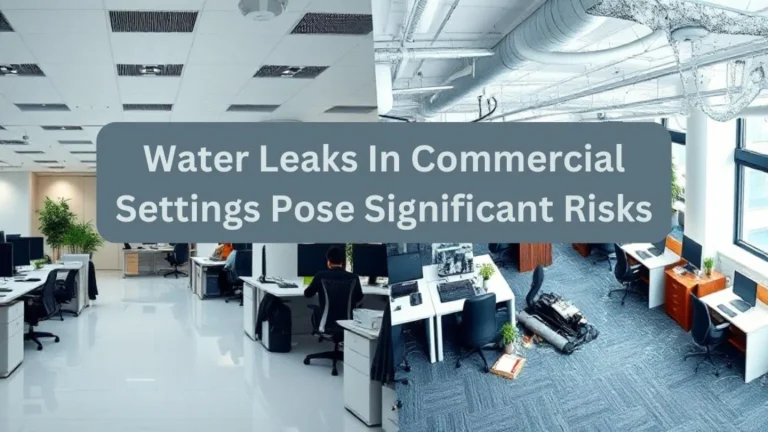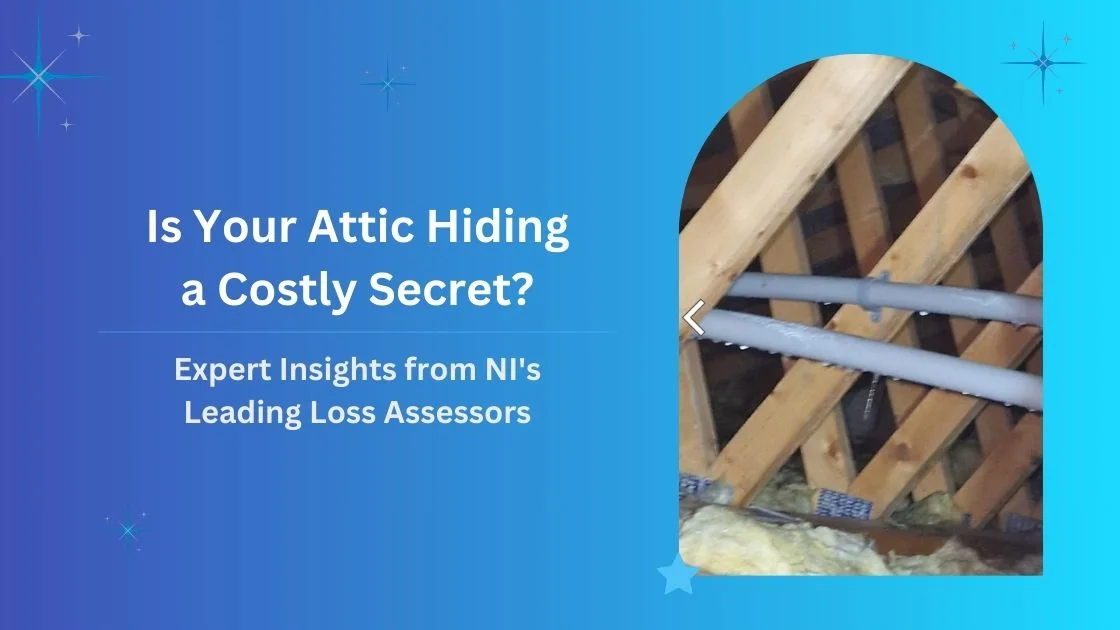In commercial settings, undetected water leaks can lead to significant financial losses and operational disruptions. Effective leak detection is crucial in safeguarding property and ensuring smooth operations. In this article, we’ll discuss why leak detection is so important for commercial properties and the benefits it provides.
- Leak detection plays a critical role in commercial settings by preventing costly water damage, which can average £1.4 million per incident.
- Common sources of leaks include faulty plumbing and damaged structures.
- Timely identification through advanced technologies, such as acoustic sensors and thermal imaging, safeguards assets and helps maintain regulatory compliance.
- Early detection not only reduces repair costs but also fosters a culture of responsibility among stakeholders.
- By implementing structured programmes, businesses can enhance operational efficiency and protect the environment.
Risks of Water Leaks
Water leaks in commercial settings pose significant risks that can have far-reaching financial and operational implications.
With potential losses averaging £1.4 million—vastly exceeding the £4,000 average for residential properties—businesses face severe threats to their financial stability.
Common causes, such as cracked humidity vents and damaged roof flashings, can lead to prolonged shutdowns of up to six months, severely impacting reputation.
Furthermore, persistent leaks can cause structural damage by corroding rebar within concrete, compromising building integrity and necessitating costly repairs.
High-rise buildings encounter unique challenges due to their complex structures, making regular maintenance and proactive leak management essential for ensuring operational continuity.
Ultimately, understanding these risks is vital for fostering a secure and resilient commercial environment.
Do you want to learn how to save money with commercial leak detection services?
Importance of Early Detection
Timely leak detection is critical for safeguarding commercial properties and ensuring operational efficiency. Early identification of water leaks can prevent extensive damage, averting costly repairs that average £1.4 million per incident.
Furthermore, the Environment Agency estimates that a small leak can waste over 3,000 gallons of water annually, underscoring the importance of resource sustainability.
By implementing regular inspections and employing advanced technologies such as acoustic sensors and thermal imaging, businesses can achieve significant cost savings and minimise operational disruptions.
These proactive measures not only protect property value but also support compliance with regulations, reducing the risk of fines and enhancing overall reputation.
Ultimately, early detection fosters a culture of responsibility and care within the commercial sector, benefiting all stakeholders involved.
Common Sources of Leaks
Identifying the common sources of leaks in commercial settings is essential for effective maintenance and risk management. Understanding these potential leak sources allows businesses to prioritise plumbing inspections and appliance maintenance, ultimately safeguarding their operations.
- Faulty plumbing fixtures
- Damaged pipes and connections
- Water-using appliances (e.g., dishwashers, ice machines)
- Structural issues in high-rise buildings (e.g., cracked humidity vents)
Leaks can result from sudden equipment failures, freezing temperatures, or excessive water pressure.
Gradual leaks often stem from wear, corrosion, or poor installation practices within plumbing systems.
By recognising these common leak sources, businesses can implement proactive maintenance strategies, minimising disruption and ensuring a secure environment for all stakeholders.
Prioritising leak detection is not only prudent but essential for sustaining operational integrity.
Leak Detection Technologies
Effective leak detection technologies play an essential role in safeguarding commercial properties from the hidden dangers of plumbing failures. Advanced methods, such as acoustic sensors and thermal imaging cameras, significantly enhance the ability to locate concealed leaks swiftly. Electronic leak detection is particularly effective for flat roofs, while video pipe inspection allows for a visual assessment of plumbing systems to identify cracks or damage. Water leak sensors automatically detect leaks, expediting response times and facilitating proactive maintenance. Furthermore, the integration of smart leak detection systems with real-time alerts empowers facility managers to address potential issues before they escalate.
| Technology | Key Benefit | Application |
|---|---|---|
| Acoustic Sensors | Sound-based leak detection | Pipes and walls |
| Thermal Imaging | Visualising temperature changes | Roofs and equipment |
| Video Pipe Inspection | Visual assessment of plumbing | Identify damage |
| Water Leak Sensors | Automatic detection | Immediate response |
Preventive Measures
Preventive measures are essential in mitigating the risks associated with leaks in commercial environments.
Regular inspections and maintenance of plumbing systems, coupled with employee training to recognise early warning signs, create a robust defence against potential water damage.
Furthermore, the installation of advanced detection devices enhances the ability to identify leaks promptly, ultimately preserving both resources and operational efficiency.
Regular Inspections and Maintenance
Regular inspections and maintenance play an essential role in safeguarding commercial properties against costly water leaks.
Implementing a structured approach not only prevents significant damage but also promotes sustainability.
- Establishing a regular inspection frequency can help identify potential leak sources.
- Adhering to maintenance schedules ensures high-risk areas, such as kitchens and restrooms, are monitored.
- Proactive measures, such as installing water leak sensors, enhance leak detection capabilities.
- Collaborating with professional services can refine risk management strategies.
Employee Training and Awareness
A robust approach to leak detection in commercial settings extends beyond regular inspections and maintenance to include comprehensive employee training and awareness.
Effective training equips staff with the knowledge to identify and report leaks early, greatly mitigating potential water damage, which can average around £1.4 million. Regular sessions familiarise employees with signs of leaks, such as sudden increases in water bills or visible stains, fostering proactive reporting.
A clear reporting protocol empowers employees, ensuring they understand their responsibility in maintaining the integrity of the facility. Additionally, heightened employee engagement in leak prevention cultivates a culture of accountability, enhancing training effectiveness and ultimately contributing to a more secure and resilient commercial environment.
Investing in employee training is essential for safeguarding both assets and resources.
Learn more about flood protection for small businesses.
Installation of Detection Devices
To effectively mitigate the risks associated with water leaks in commercial settings, the installation of advanced detection devices is paramount. Proper device placement is essential, focusing on high-risk areas such as kitchens, washrooms, and utility rooms.
Adhering to installation guidelines guarantees peak performance and reliability.
- Utilise smart systems for real-time alerts, enabling swift responses.
- Integrate advanced technologies like acoustic sensors for precise leak identification.
- Conduct regular maintenance to maintain device effectiveness.
- Empower employees through training on device usage to facilitate prompt reporting.
Implementing LDAR Programs
Implementing an effective Leak Detection and Repair (LDAR) programme is essential for commercial settings aiming to minimise environmental impact and ensure regulatory compliance. A systematic approach involves regular inspections, advanced technologies, and comprehensive training to guarantee adherence to regulations and effective leak management.
| Key Components | Description |
|---|---|
| Identification | Determine components subject to regulations |
| Routine Checks | Conduct regular inspections for leaks |
| Advanced Tools | Employ acoustic sensors and thermal imaging |
| Staff Training | Educate employees on LDAR procedures |
| Documentation | Maintain records for compliance and tracking |
The benefits of LDAR extend beyond compliance, fostering a safer, more sustainable environment while enhancing operational efficiency. Embracing these practices cultivates a culture of responsibility and belonging among all stakeholders.
Monitoring and Repair Strategies
Effective monitoring techniques are paramount in commercial leak detection, employing advanced tools such as acoustic sensors and thermal imaging to identify issues promptly.
Coupled with timely repair protocols, businesses can significantly reduce the risk of extensive damage and financial loss.
Establishing a structured approach to both monitoring and repairs is essential for maintaining system integrity and compliance.
Effective Monitoring Techniques
A robust monitoring strategy is essential for the successful detection and management of leaks in commercial environments.
Effective techniques harness advanced technology to ensure accuracy and compliance.
- Employ electronic data loggers for precise leak detection
- Conduct regular audits of your leak detection and repair (LDAR) programme
- Implement monitoring software for real-time data analysis
- Maintain continuous monitoring after repairs to uphold system integrity
Timely Repair Protocols
Timely repairs are essential in mitigating the risks associated with leaks in commercial settings, as even a small leak can result in the loss of over 3,000 gallons of water annually.
Establishing clear repair timelines enhances protocol efficiency, ensuring that detected leaks are resolved swiftly. This not only helps maintain compliance with regulatory requirements but also protects the integrity of the property.
Implementing a systematic monitoring approach allows for the early identification of leaks, prioritising repairs based on severity and potential impact. Continuous monitoring after repairs is vital to confirm leak resolution and prevent recurrence.
Regular audits of the leak detection and repair (LDAR) programme further support proactive measures, fostering a culture of accountability and commitment to infrastructure health.
Key Takeaways
- Early leak detection prevents extensive damage and costly repairs, averting average losses of £1.4 million in commercial properties.
- Regular inspections and advanced technologies, such as acoustic sensors and thermal imaging, enhance leak identification and monitoring.
- Implementing LDAR programmes ensures compliance with regulations, reducing fines and environmental impact.
- Timely repairs based on severity minimise operational disruptions and uphold business reputation.
- Fostering a culture of responsibility among employees supports proactive leak management and sustainability efforts.
Secure Your Business with Expert Leak Detection!
Act now to safeguard your business from the costly and disruptive impact of leaks. Every minute counts when it comes to preventing extensive water damage—don’t wait until it’s too late!
Schedule a leak assessment with our top-rated commercial leak detection service in Northern Ireland. Our specialists are equipped to identify and address leaks quickly, ensuring minimal disruption and maximum protection for your business.
Take the proactive step to secure your commercial property today. Schedule your leak assessment and let us help you maintain a safe and efficient work environment.
Don’t let a minor leak turn into a major disaster—act now!



